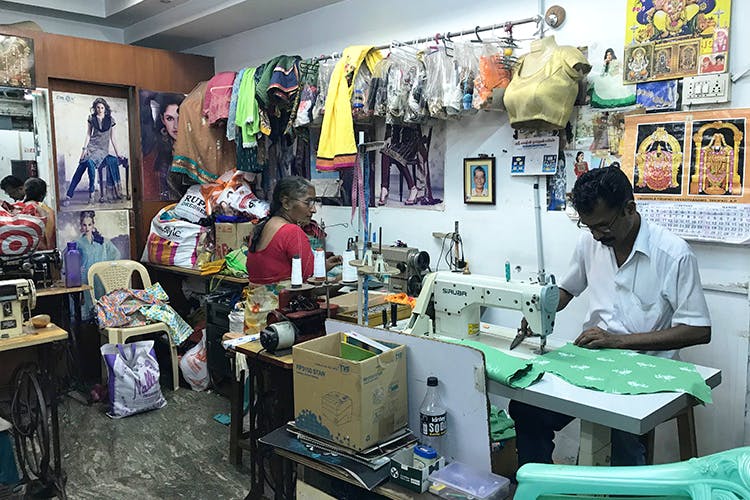Tailor Perth Quality: Where Top Quality Fulfills Personalized Tailoring
Tailor Perth Quality: Where Top Quality Fulfills Personalized Tailoring
Blog Article
Understanding the Tailoring Refine: From Fabric Choice to Final Fitting for the Ideal Closet
The tailoring procedure is a complex interaction of art and scientific research, starting with the essential choice of material selection and finishing in the accurate adjustments of last fittings. Each material type brings special top qualities that influence not just the aesthetic allure however also the garment's long life and suitability for numerous occasions.
Importance of Textile Selection
Selecting the appropriate fabric is important in the tailoring process, as it directly affects the convenience, resilience, and overall visual of the last garment (tailor perth). The option of fabric sets the foundation for the garment's design, performance, and functionality. Different materials possess special residential properties, such as stretch, weight, and breathability, which can dramatically influence just how the garment drapes and fits the body
Furthermore, material option affects the garment's durability and simplicity of treatment. Top quality materials can stand up to deterioration, preserving their appearance and structure in time, while lower-quality materials may lead to pilling or fading. In addition, the right material contributes to the garment's ability to change throughout celebrations and periods, thus enhancing flexibility.
A tailored item made from an appropriate textile not just showcases craftsmanship but additionally boosts the user's confidence. Consequently, recognizing the subtleties of material choice is vital for any type of tailoring undertaking. It makes certain that the last product not just satisfies the aesthetic needs of the client but additionally lines up with useful demands, thereby achieving an unified balance in between form and feature in the tailored closet.
Sorts Of Fabrics and Their Usages
Comprehending the various sorts of fabrics readily available is important for making educated choices during the customizing process. Each textile has special features that determine its viability for specific garments and celebrations.
Its convenience allows it to be tailored into every little thing from t shirts to outfits. Its natural elasticity assists garments preserve form over time.
Silk shows deluxe and is lightweight, making it ideal for eveningwear and delicate blouses; nevertheless, it needs careful handling as a result of its fragility. Linen, with its textured finish, is a popular selection for warm environments, offering a airy and crisp feel, but it wrinkles quickly, which might affect the garment's look.
Artificial textiles, such as polyester and nylon, deal resilience and resistance to wrinkles, making them suitable for everyday wear and energetic garments. Comprehending these material types and their buildings permits far better decision-making, making certain that each customized item not only fits well but likewise lines up with the designated purpose and occasion.
The Tailoring Strategies Clarified
The art of customizing depends on a selection of strategies that transform fabric right into well-fitted garments. Central to this procedure is pattern composing, where a dressmaker develops themes based on the client's measurements and desired style. This initial action makes certain that the garment will certainly fit the user correctly prior to any cutting happens.
As soon as patterns are established, reducing strategies enter play. Precision is paramount as inaccuracies can bring about misfitting garments. Tailors usually use various reducing techniques, such as single-layer cutting for detailed styles and multiple-layer cutting for performance on conventional patterns.
Basting is one more crucial method, allowing dressmakers to temporarily sew material assemble for a preliminary installation. This approach uses the chance to analyze the drape and general shape before last stitching.
Seaming techniques, consisting of french joints and flat-felled seams, boost the garment's longevity and aesthetic allure. Tailors also utilize techniques such as interfacing and cushioning to supply framework and shape to certain locations, like collars and shoulders.
Finally, finishing methods, consisting of hemming and side finishing, make sure the garment's durability while giving a polished look. With each other, these strategies form the foundation of effective tailoring, leading to exquisite, custom-fit clothing.
Suitable Adjustments and Factors To Consider

Trick considerations include web link the shoulder fit, which needs to neither droop nor restrict activity, and the sleeve size, which should permit comfy arm motion while maintaining a sleek look. Furthermore, modifications at the waistline can improve the shape, with options to allow out or absorb material as required.
The rise of pants is one more important factor; it must sit pleasantly over the hips without creating discomfort, permitting ease of activity. Hemming sizes for both pants and skirts need to show the wearer's recommended design while appreciating proportions.

Keeping Your Tailored Clothing
Proper maintenance of tailored garments is necessary to maintaining their fit and look over time. To ensure longevity, regular cleansing is paramount. Always follow the care tag instructions, which may suggest completely dry cleansing for delicate materials or device washing for more sturdy products. Stay clear of constant laundering, as this can put on down the material and change the garment's shape.
Storage is just as essential; use padded wall mounts for coats and coats to maintain shoulder framework, and shop trousers folded up nicely or hung to stop creasing. Safeguard garments from direct sunshine, which can discolor colors and damages fibers.
Furthermore, periodic inspections for small repairs can stop larger concerns. Look for loose switches, fraying seams, or signs of moth damages, dealing with these problems immediately to maintain the garment's honesty.
Finally, consider seasonal turning. Wearing customized pieces in moderation permits materials to recoup, prolonging their lifespan. By carrying out these maintenance approaches, you can make certain that your tailored garments continue to be as beautiful as the day you initially wore them, improving your ideal wardrobe for several years to find.
Verdict
The tailoring procedure, incorporating material selection, skilled methods, and discover this specific fitting modifications, plays a crucial function in creating garments that improve both convenience and design. Each stage contributes to the total effectiveness of the last product, ensuring that garments not just fits well but likewise mirrors individual identification. Moreover, comprehending the value of upkeep extends the life of customized garments, solidifying their worth in a well-curated closet. A thorough technique to tailoring culminates in a sleek and positive appearance.
Selecting the ideal material is vital in the customizing process, as it directly influences the comfort, resilience, and overall aesthetic of the last garment. The option of fabric establishes the foundation for the garment's performance, performance, and style. Various materials possess unique residential properties, such as stretch, weight, and breathability, which can considerably affect just how the garment drapes and fits the body.
The art of tailoring counts on a range of methods that transform textile into well-fitted garments.The customizing process, encompassing material selection, competent techniques, and specific fitting adjustments, plays a vital role in developing garments that enhance both convenience and style.
Report this page